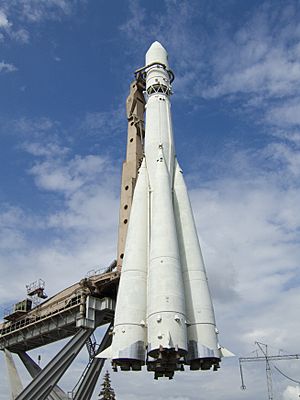Vostok (rocket family) facts for kids

Vostok 8K72K rocket on display in Moscow at the Exhibition of Achievements of National Economy
|
|
| Function | Carrier rocket |
|---|---|
| Manufacturer | RKK Energia |
| Country of origin | Soviet Union |
| Size | |
| Mass | 280,000–290,000 kg (620,000–640,000 lb) |
| Stages | 3 |
| Capacity | |
| Payload to LEO | 4,725 kilograms (10,417 lb) |
| Associated rockets | |
| Family | R-7 |
| Comparable | Atlas Titan |
| Launch history | |
| Status | Retired |
| Launch sites | Baikonur: LC-1/5, 31/6 Plesetsk: LC-41/1, 43/3, 43/4 |
| Total launches | Vostok-L: 4 Vostok-K: 13 Vostok-2: 45 Vostok-2M: 94 Soyuz/Vostok: 2 |
| Successes | Vostok-L: 3 Vostok-K: 11 Vostok-2: 40 Vostok-2M: 92 Soyuz/Vostok: 2 |
| Failures | Vostok-L: 1 Vostok-K: 2 Vostok-2: 5 Vostok-2M: 2 |
| First flight | 15 May 1960 (Vostok-L) |
| Last flight | 29 August 1991 (Vostok-2M) |
| Notable payloads | Vostok Zenit Meteor |
| First stage (Block B, V, G, D) | |
| Engines | 1 RD-107-8D74-1959 |
| Thrust | 970.86 kN |
| Burn time | 118 seconds |
| Fuel | Kerosene/LOX |
| Second stage (Block A) | |
| Engines | 1 RD-108-8D75-1959 |
| Thrust | 912 kN |
| Burn time | 301 seconds |
| Fuel | RP-1/LOX |
| Third stage (Block E) | |
| Engines | 1 RD-0109 |
| Thrust | 54.5 kN |
| Burn time | 365 seconds |
| Fuel | Kerosene/LOX |
The Vostok (which means "East" in Russian) was a famous family of rockets from the Soviet Union. These rockets were super important because they launched the very first artificial satellite, Sputnik 1, and the first human into space as part of the Vostok programme. The Vostok rockets were actually a part of a bigger group of rockets called the R-7 family.
On March 18, 1980, a Vostok-2M rocket had a serious accident at its launch site in Plesetsk. This happened during a fueling operation. An investigation later found that a small change in the materials used for some filters led to a chemical reaction. This reaction caused the rocket to explode.
Contents
What Are Vostok Rockets?
The Vostok rocket family was created from the Soviet R-7 Semyorka intercontinental ballistic missile (ICBM). An ICBM is a very long-range missile designed to carry a nuclear warhead. However, the Vostok rockets were changed to launch spacecraft instead.
These rockets were designed specifically for the human spaceflight program. This program aimed to send humans into space. The Vostok rockets successfully launched the first artificial satellite, Sputnik 1, into orbit. They also launched the first crewed spacecraft, Vostok, carrying humans into space.
Different Types of Vostok Rockets
Over time, several versions of the Vostok rocket were developed for different missions. Here are the main types:
- Luna 8K72: This version was used to launch the early Luna spacecraft. These spacecraft explored the Moon.
- Vostok-L 8K72: This rocket was a version of the Luna. It was used to launch early test versions of the Vostok spacecraft.
- Vostok-K 8K72K: This was an improved version. It was the rocket actually used to send humans into space.
- Vostok-2 8A92: This type of Vostok rocket was used throughout the 1960s. It launched Zenit reconnaissance satellites. These satellites were used to take pictures from space.
- Vostok-2M 8A92M: This was a changed version of the Vostok-2. It was used to launch Meteor weather satellites. These satellites went into higher orbits to help predict weather.
- Soyuz/Vostok 11A110: This was a mix of the Soyuz and Vostok rockets. It was used for two launches as a temporary solution.
How the Vostok 8K72K Rocket Worked
The Vostok 8K72K rocket had three main parts, called stages. Each stage had its own engines and fuel. They would fire in sequence to push the rocket higher and faster.
First Stage: Block B, V, G, D
This stage had four booster rockets attached to the main core.
- Weight: About 43,300 kilograms (almost 95,500 pounds) when full.
- Engines: Each of the four boosters had one RD-107 engine.
- Power: Together, they produced a lot of thrust, about 3.88 million Newtons.
- Burn Time: These engines burned for about 118 seconds.
- Fuel: They used liquid oxygen (LOX) and kerosene.
Second Stage: Block A (Core Stage)
This was the main central part of the rocket.
- Weight: About 100,400 kilograms (over 221,000 pounds) when full.
- Engine: It had one powerful RD-108 engine.
- Power: This engine produced about 912,000 Newtons of thrust.
- Burn Time: It burned for about 301 seconds.
- Fuel: It also used liquid oxygen (LOX) and kerosene.
Third Stage: Block E
This was the top stage of the rocket. It gave the final push to get the spacecraft into orbit.
- Weight: About 7,775 kilograms (over 17,000 pounds) when full.
- Engine: It had one RD-0109 engine.
- Power: This engine produced about 54,500 Newtons of thrust.
- Burn Time: It burned for about 365 seconds.
- Fuel: Like the other stages, it used liquid oxygen (LOX) and kerosene.
Images for kids
See also
 In Spanish: Vostok (cohete) para niños
In Spanish: Vostok (cohete) para niños
- Vostok 1
- Vostok programme
- Vostok spacecraft


